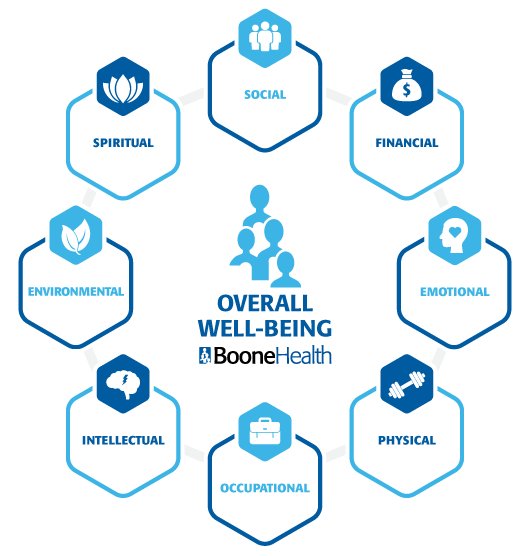8 Dimensions of Well-Being
The National Wellness Institute defines well-being as “an active process through which we become more aware of, and make choices toward, a more successful existence”. Well-being is multidimensional and addresses all areas of life, including:
-

8 DIMENSIONS OF WELL-BEING
Learn more about the 8 dimensions of well-being! -

FINANCIAL WELL-BEING
Satisfaction with current and future financial situations:- Attend the Financial Literacy class.
- Bring your lunch instead of eating out.
- Track your spending habits and reflect on how/where you spend money.
- Set a goal to save money for the future.
- Talk with a financial advisor.
-

OCCUPATIONAL WELL-BEING
Personal satisfaction and enrichment derived from one’s work (paid and unpaid):- Focus on the things you like about your job – Why do you work, why did you choose your job, and how do you connect those together.
- Write out your career goals.
- Take breaks away from your workspace.
- Connect with your coworkers.
- Participate in professional development opportunities.
-

PHYSICAL WELL-BEING
Recognizing the need for medical care, physical activity, nutrition, and sleep:- Replace a sugary snack with a piece of fruit.
- Join a recreation league or team sport.
- Get a good night’s sleep by turning off electronics.
- Have a medical home and get regular check-ups.
- Use a standing workstation or yoga ball at your desk.
-

EMOTIONAL WELL-BEING
Developing skills and strategies to cope with stress:- Establish a routine.
- Laugh! Don’t take life so seriously.
- Seek support from a family member, friend or counselor.
- Practice formal and informal mindfulness activities.
- Make a gratitude list.
-

SPIRITUAL WELL-BEING
Search for meaning and purpose in the human experience:- Engage in a religious practice, such as attending a religious service.
- Use prayer and meditation.
- Practice mindfulness and yoga.
- Commit a random act of kindness.
- Connect with nature.
- Keep a journal and reflect on personal growth.
-

SOCIAL WELL-BEING
Developing a sense of connection and a well-developed support system::- Reconnect with an old friend or meet someone new.
- Enjoy family dinners at the table or eat lunch with coworkers in the break room.
- Share your talent and skills by volunteering in the community.
- Join a club or organization.
- Say thank you and compliment others.
-

INTELLECTUAL WELL-BEING
Recognizing creative abilities and finding ways to expand knowledge and skills:- Do crossword puzzles or play brain games.
- Tap into culture – attend a play, sporting event, museum, or live concert.
- Learn how to play an instrument or speak another language.
- Read for pleasure.
- Attend a community class or workshop.
-

ENVIRONMENTAL WELL-BEING
Good health by occupying pleasant, stimulating environments that support well-being:- Connect with nature (walk barefoot, play outside).
- Participate in a clean-up event.
- Recycle, Reuse, and Reduce – ask for paper bags at the grocery store instead of plastic, donate unwanted clothing.
- Walk or bike to work a couple of times a week if possible.
- Go to the farmer’s market and choose locally sourced foods.
